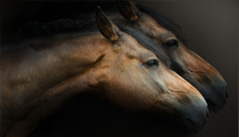
|
|
Equine chiropractic care
The proper functioning of the back and neck is an important basis for maintaining the horse’s performance. For this reason, health care should be high on the agenda of any horse owner.
Confirmation and Build
When selecting your horse for a particular discipline, you should always pay attention to the horse’s build. Many breeds have been selectively bred for years to achieve certain goals and are therefore suitable for particular disciplines such as dressage, jumping or western riding. Horses with long backs often have a tendency toward muscle and ligaments injuries, whereas horses with an upright shoulder often have problems in their forelegs.
Massage
Massage encourages circulation and metabolism within the muscles, promoting the supply of nutrients and removal of toxins. Massage relaxes tense muscles enabling them to function better. It can also promote healing in muscular injuries by loosening muscle fiber adhesions and increasing the flow of fluid and toxins from the tissue.
Training
Horses have an increasing tendency to subluxate and damage the spine if ligaments, tendons and muscles have not been developed to cope with the demands they are paced under. Interval training, suitable warm-up procedures and variety in training can help optimally condition sport horses.
Equipment and Saddle
Ensure that your saddle fits your horse. If a saddle fits correctly, no thick padded saddle cloth/numnah or additional pads are necessary. Check your saddle regularly to see whether the flocking is evenly worn, there is a asymmetry of the panels or tree and that the saddle tree is intact. Any dampness under the saddle area after riding should be even in distribution.
Shoes
It is practically impossible for a poorly shod horse or a horse with badly fitting shoes to have or maintain a spine that functions properly. Heels that are too high or underrun, toes that are too long or uneven hoof wall length can negatively affect the mobility and posture of the horse. For the limb and spinal joints to function properly, it is necessary for the horse to be correctly trimmed or shod.
Training Aids
Many horses are forced into a desired frame with side-reins, martingales, draw-reins and other auxiliary reins. Used correctly, some of these aids can help in training: however, in the wrong hands they do the opposite. If a restriction in the spine already exists, these aids can make the problem even worse. Continual jerking and pulling on the lead rope or chain, especially with young horses, can lead to tension in the poll and neck area.
Environment
Most sport horses are still kept in stables with limited space in which to move about and turnout is often restricted. The more time a horse spends in the stable without freedom of movement, the worse its coordination becomes. Its natural balance suffers, leading to an increased danger of injury. Bucking and rolling are the horse’s natural means of mobilizing its spine. Make sure your horse gets enough exercise.
Back to the top
 Powered by quicksite v 4.6.7© 2002-2019 All rights reserved
Powered by quicksite v 4.6.7© 2002-2019 All rights reserved
